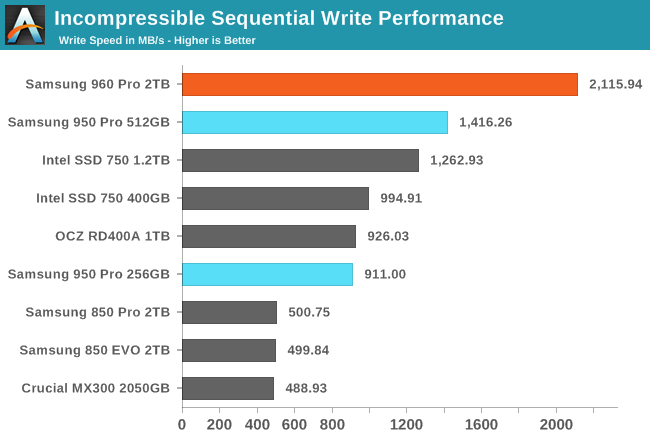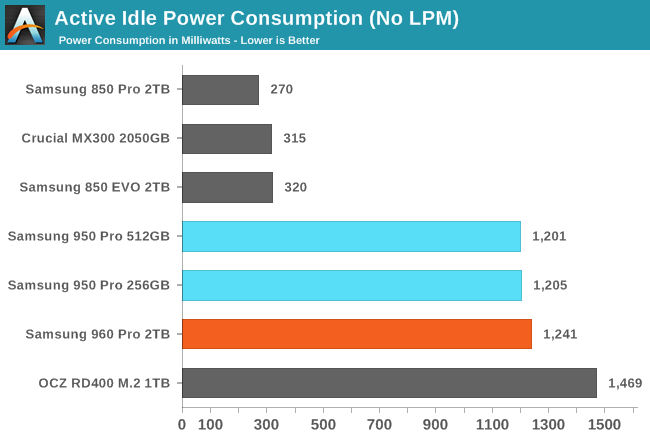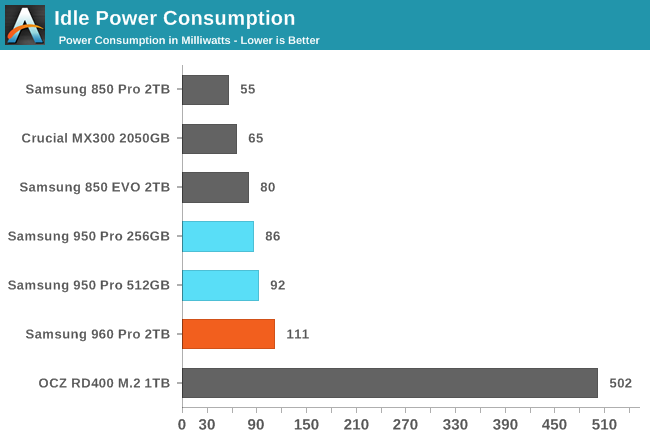The Samsung 960 Pro (2TB) SSD Review
by Billy Tallis on October 18, 2016 10:00 AM ESTATTO
ATTO's Disk Benchmark is a quick and easy freeware tool to measure drive performance across various transfer sizes.
 |
|||||||||
The 960 Pro hits full performance at 32kB or larger transfers, while the Intel SSD 750 doesn't reach its highest read speeds until 1MB transfers and the OCZ RD400 needs 512kB transfers for its highest read speeds. Unlike the 512GB 950 Pro, the 960 Pro does not hit any severe thermal throttling.
AS-SSD
AS-SSD is another quick and free benchmark tool. It uses incompressible data for all of its tests, making it an easy way to keep an eye on which drives are relying on transparent data compression. The short duration of the test makes it a decent indicator of peak drive performance.


The 960 Pro's read speed breaks away from the pack of other PCIe SSDs but still doesn't come close to the advertised 3.5GB/s. The write speed stands out even more and very slightly exceeds the advertised speed of 2100MB/s.
Idle Power Consumption
Since the ATSB tests based on real-world usage cut idle times short to 25ms, their power consumption scores paint an inaccurate picture of the relative suitability of drives for mobile use. During real-world client use, a solid state drive will spend far more time idle than actively processing commands.
There are two main ways that a NVMe SSD can save power when idle. The first is through suspending the PCIe link through the Active State Power Management (ASPM) mechanism, analogous to the SATA Link Power Management mechanism. Both define two power saving modes: an intermediate power saving mode with strict wake-up latency requirements (eg. 10µs for SATA "Partial" state) and a deeper state with looser wake-up requirements (eg. 10ms for SATA "Slumber" state). SATA Link Power Management is supported by almost all SSDs and host systems, though it is commonly off by default for desktops. PCIe ASPM support on the other hand is a minefield and it is common to encounter devices that do not implement it or implement it incorrectly. Forcing PCIe ASPM on for a system that defaults to disabling it may lead to the system locking up; this is the case for our current SSD testbed and thus we are unable to measure the effect of PCIe ASPM on SSD idle power.
The NVMe standard also defines a drive power management mechanism that is separate from PCIe link power management. The SSD can define up to 32 different power states and inform the host of the time taken to enter and exit these states. Some of these power states can be operational states where the drive continues to perform I/O with a restricted power budget, while others are non-operational idle states. The host system can either directly set these power states, or it can declare rules for which power states the drive may autonomously transition to after being idle for different lengths of time.
The big caveat to NVMe power management is that while I am able to manually set power states under Linux using low-level tools, I have not yet seen any OS or NVMe driver automatically engage this power saving. Work is underway to add Autonomous Power State Transition (APST) support to the Linux NVMe driver, and it may be possible to configure Windows to use this capability with some SSDs and NVMe drivers. NVMe power management including APST fortunately does not depend on motherboard support the way PCIe ASPM does, so it should eventually reach the same widespread availability that SATA Link Power Management enjoys.
We report two idle power values for each drive: an active idle measurement taken with none of the above power management states engaged, and an idle power measurement with either SATA LPM Slumber state or the lowest-power NVMe non-operational power state, if supported.

The active idle power consumption of the PCIe SSDs is still far higher than is typical for SATA SSDs, and is enough to keep their temperatures relatively high as well. The 960 Pro 2TB draws only slightly more power than the 950 Pro.

With power saving modes enabled, the Samsung NVMe SSDs are almost as efficient as typical SATA SSD, with the 960 Pro unsurprisingly drawing a little more power than the lower-capacity 950 Pros. The OCZ RD400 does benefit some from power management, but still draws far more than it should.










72 Comments
View All Comments
emn13 - Wednesday, October 19, 2016 - link
Especially since NAND hasn't magically gotten lots faster after the SATA->NVMe transition. If SATA is fast enough to saturate the underlying NAND+controller combo when they must actually write to disk, then NVMe simply looks unnecessarily expensive (if you look at writes only). Since the fast NVMe drives all have ram caches, it's hard to detect whether data is properly being written.Perhaps windows is doing something odd here, but it's definitely fishy.
jhoff80 - Tuesday, October 18, 2016 - link
This is probably a stupid question because I've been changing that setting for years on SSDs without even thinking about it and you clearly know more about this than I do, but does the use of a drive in a laptop (eg battery-powered) or with a UPS for the system negate this risk anyway? That was always my impression, but it could very much be wrong.shodanshok - Tuesday, October 18, 2016 - link
Having a battery, laptops are inherently safer than desktop against power loss. However, a bad (or missing) battery and/or a failing cable/connector can expose the disks to the very same unprotected power-loss scenario.Dr. Krunk - Sunday, October 23, 2016 - link
What happens if accidently press the battery release button and it pops out just enough to lose connection?woggs - Tuesday, October 18, 2016 - link
I would love to see Anandtech do a deep dive into this very topic. It's important. I've heard that windows and other apps do excessive cache flushing when enabled and that's also a problem. I've also heard intel SSDs completely ignore the cache flush command and simply implement full power loss protection. Batching writes into ever larger pieces is a fact of SSD life and it needs to be done right.voicequal - Tuesday, October 18, 2016 - link
Agreed. Last year I traced slow disk i/o on a new Surface Pro 4 with 256GB Toshiba XG3 NVMe to the write-cache buffer flushing, so I checked the box to turn it off. Then in July, another driver bug caused the Surface Pro 4 to frequently lock up and require a forced power off. Within a few weeks I had a corrupted Windows profile and system file issues that took several DISM runs to clean up. Don't know for sure if my problem resulted from the disabled buffer flushing, but I'm now hesitant to reenable the setting.It would be good to understand what this setting does with respect to NVMe driver operation, and interesting to measure the impact / data loss when power loss does occur.
Kristian Vättö - Tuesday, October 18, 2016 - link
I think you are really exaggerating the problem. DRAM cache has been used in storage well before SSDs became mainstream. Yes, HDDs have DRAM cache too and it's used for the same purpose: to cache writes. I would argue that HDDs are even more vulnerable because data sits in the cache for a longer time due to the much higher latency of platter-based storage.Because of that, all consumer friendly file systems have resilience against small data losses. In the end, only a few MB of user data is cached anyway, so it's not like we talk about a major data loss. It's small enough not to impact user experience, and the file system can recover itself in case there was metadata in the lost cache.
If this was a severe issue, there would have been a fix years ago. For client-grade products there is simply no need because 100% data protection and uptime are not needed.
shodanshok - Tuesday, October 18, 2016 - link
The problem is not the cache, rather ignoring cache flushes requests. I know DRAM caches are used from decades, and when disks lied about flushing them (in the good old IDE days), catastrophic filesystem failure were much more common (see XFS or ZFS FAQs / mailing lists for some reference, or even SATA command specifications).I'm not exaggerating anything: it is a real problem, greatly debated in the Linux community in the past. From https://lwn.net/Articles/283161/
"So the potential for corruption is always there; in fact, Chris Mason has a torture-test program which can make it happen fairly reliably. There can be no doubt that running without barriers is less safe than using them"
This quote is ext3-specific, but other journaled filesystem behave in very similar manners. And hey - the very same Windows check box warns you about the risks related to disabling flushes.
You should really inquiry Microsoft about what these check box do on its NVMe driver. Anyway, suggesting to disable cache flushes is a bad advise (unless you don't use your PC for important things).
Samus - Wednesday, October 19, 2016 - link
I don't think people understand how cache flushing works at the hardware level.If the operating system has buffer flushing disabled, it will never tell the drive to dump the cache, for example, when an operation is complete. In this event, a drive will hold onto whatever data is in cache until the cache fills up, then the drive firmware will trigger the controller to write the cache to disk.
Since OS's randomly write data to disk all the time, bits here and there go into cache to prevent disk thrashing/NAND wear, all determined in hardware. This has nothing to do with pooled or paged data at the OS level or RAM data buffers.
Long story short, it's moronic to disable write buffer flushing, where the OS will command the drive after IO operations (like a file copy or write) complete, ensuring the cache is clear as the system enters idle. This happens hundreds if not thousands of times per minute and its important to fundamentally protect the data in cache. With buffer flushing disabled the cache will ALWAYS have something in it until you shutdown - which is the only time (other than suspend) a buffer flush command will be sent.
Billy Tallis - Wednesday, October 19, 2016 - link
"With buffer flushing disabled the cache will ALWAYS have something in it until you shutdown - which is the only time (other than suspend) a buffer flush command will be sent."I expect at least some drives flush their internal caches before entering any power saving mode. I've occasionally seen the power meter spike before a drive actually drops down to its idle power level, and I probably would have seen a lot more such spikes if the meter were sampling more than once per second.